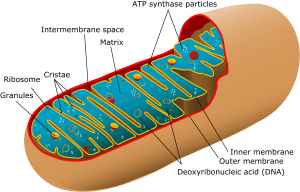Mitochondria: Structure and Function
Introduction
Mitochondria are specialized structures that are unique to the animal, plant, and fungal cells. They serve as batteries, powering the cell and the organism as a whole through different functions. Although mitochondria are an integral part of the cell, evidence shows that primitive bacteria evolved from them.
With one fundamental brick, all living organisms are constructed: the cell. In some cases, an entire organism constitutes a single cell. Cells contain genetic material (DNA and RNA) and perform essential functions, such as protein synthesis and metabolism. Also, cells are able to self-replicate. Within the cells of various organisms, however, the level of organization varies. Based on these differences, organisms are divided into two groups: eukaryotes and prokaryotes.
Structure
- Mitochondria have an inner and outer membrane, with a space between them in the intermembrane. There are proteins known as prions in the outer membrane, which allow ions to move into and out of the mitochondrion. On the outer membrane, enzymes involved in the elongation of fatty acids and the oxidation of adrenaline can also be found.
- In addition to DNA, RNA, ribosomes, and calcium granules, the space within the inner membrane of the mitochondrion is known as the matrix that contains the enzymes of the Krebs (TCA) and fatty acid cycles.
- A variety of enzymes are found in the inner membrane. It contains ATP synthase and transport proteins that control the movement of metabolites into and out of the matrix, which generates ATP in the matrix.
- The inner membrane is arranged into cristae to increase the surface area available through oxidative phosphorylation for energy production.

Function
- In order to generate energy, the main function of mitochondria is to metabolize or break down carbohydrates and fatty acids. In the form of a chemical molecule called ATP, eukaryotic cells utilize energy (adenosine triphosphate).
- Within the mitochondrial matrix, ATP generation takes place, although, outside the organelle, the initial steps of carbohydrate (glucose) metabolism occur.
- Glucose is first converted into pyruvate and then transported into the matrix. On the other hand, fatty acids enter the mitochondria the way they are.
- In the course of three linked steps, ATP is produced. First, pyruvate and fatty acids are converted into a molecule known as acetyl-CoA using enzymes present in the matrix.
- For a second chemical reaction known as the citric acid cycle or Krebs Cycle, this then becomes the starting material. This step produces plenty of carbon dioxide and two electron-rich additional molecules, NADH and FADH2.
- The two molecules move to the inner mitochondrial membrane and the third step begins phosphorylation of oxidative.
- NADH and FADH2 donate their electrons to oxygen in this last chemical reaction, which leads to conditions suitable for ATP formation.
- Mitochondria are the primary site of ATP synthesis in the aerobic cell, using the free energy of the oxidation of metabolic fuels by oxygen.
- They have an internal membrane comprising 4 complexes of the electron transport chain, ATP synthase, and special transports for metabolites, including citrate cycle enzymes and beta-oxidative enzymes.
- Substrate oxidation electrons join the electron transport chain at complex I or complex II, and then flow successively to complex III, complex IV, and eventually to oxygen.
- The redox pumps are molecules I, III, and IV, and the transportation of the protons from the matrix produces an electrical proton gradient (motive proton) in the inner membrane. Proton motive power.
1. Production of ATP
The production of ATP, the energy currency of cells, is perhaps the most well-known role for mitochondria. This complex, multi-step process is vital to the proper functioning of the body, and dysfunction can contribute to a range of diseases, from diabetes to Parkinson’s disease to rare genetic disorders.
2. Calcium Homeostasis
The exchange of mitochondrial calcium is the flow of calcium into and out of the mitochondria of a cell, a process that is important in metabolic regulation and cell death.
3. Regulation of Innate Immunity
Innate immunity is the in-born system that recognizes pathogens and responds to infection, providing instant, non-specific defense. In the innate reaction to viral infections, mitochondrial antiviral signaling protein (MAVS) plays a key role, helping to induce antiviral and anti-inflammatory pathways.
4. Programmed Cell Death
Apoptosis is the highly controlled programmed cell death process used in a number of biological processes by multicellular organisms, including intrauterine development, mopping up damaged cells, and maintaining cell numbers. Both an intrinsic and extrinsic pathway can activate the production of apoptotic bodies that are engulfed by phagocytes.
5. Stem Cell Regulation
In the maintenance of pluripotency, differentiation, and reprogramming of induced pluripotent stem cells, mitochondria are thought to play crucial roles.
Others
The major regulators of calcium homeostasis, free radical development, steroid synthesis, and apoptosis are ATP synthesis mitochondria, and both of these factors may also be correlated with the critical pathways involved in neurodegenerative diseases.
In neurodegenerative disorders, membrane structures are directly changed, defining mitochondrial membranes as sites for potential therapeutic strategies.
References
